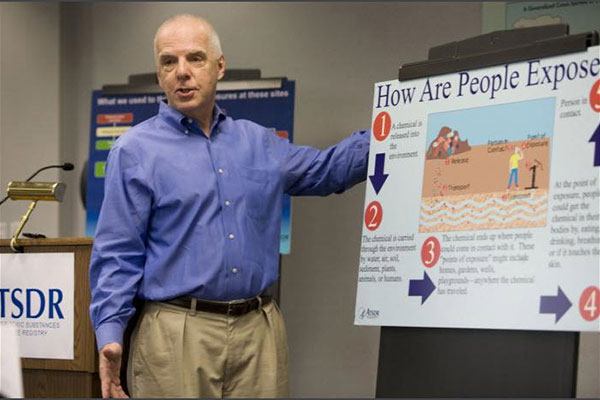Players in the PHA Process
This section describes the different entities and roles of those involved in the PHA process.
ATSDR staff and its cooperative agreement recipients are responsible for conducting the PHA process, for communicating the findings of their evaluations to the public, and for involving the community and responding to community health concerns. The process requires coordinated efforts that may include local/county, state, and federal government agencies; tribal nations; community residents and leaders; and parties responsible for operating and/or cleaning up a particular site. Collaboration among these different partners is a critical component of the PHA process.
ATSDR often uses a multidisciplinary team approach to conduct the PHA process. Early in the process, if appropriate, a site lead will assemble a site team representing various disciplines (as conditions at the site warrant), including health assessors, health communication specialists, community involvement specialists, health educators, physicians, and others.
The experience and expertise of each team member helps to:
- Coordinate the PHA process activities.
- Collect relevant data and information.
- Engage and communicate with the community and other stakeholders.
- Evaluate the data and health effects to determine conclusions and public health recommendations.
- Communicate the findings and public health actions to the community, stakeholders, and the general public.
The cooperative agreement program — ATSDR’s Partnership to Promote Local Efforts to Reduce Environmental Exposure (APPLETREE) — may fund state health departments, tribal governments, and U.S. territories to conduct the PHA to evaluate and respond to environmental public health issues.
The site lead coordinates site-related project activities and preparation of written documents. The site lead may give technical help to communities, states, tribes, and other agencies. They also help with environmental justice activities. Different members of the site team will often help write portions of PHA-process related materials (e.g., a health physicist could write a PHA section on radiation effects), with the site lead coordinating the compilation and review of site documents.
The groups listed below are typically part of the PHA process. Also refer to this table for information on the roles of individuals who may be included as part of a site team.
- Health Assessors. Health assessors are often the leader of the site team, coordinating the PHA process activities, and working with subject matter experts (SMEs) to gather and evaluate data. Health assessors may come from a range of academic backgrounds, including environmental health, engineering, toxicology, industrial hygiene, health physics, and others. Depending on their expertise and background, as well as the particular site issues, health assessors may perform all or most of the PHA process components on their own, or they may consult with others to assist with some aspects of the PHA process. This table lists individuals with various expertise and disciplines who may be on the site team or provide expert consultation to the health assessor during the PHA process. Usually, the health assessors are responsible for writing the document or portions of the document that summarize the findings of the PHA process.

ATSDR often uses a multidisciplinary team approach to ensure that information is accurate and up to date, identifies and addresses community concerns, and fosters cooperative efforts in implementing recommendations and public health activities.
- SMEs. During the PHA process, the health assessor might consult with a variety of SMEs in various subject areas. There are SMEs for certain chemicals and topics, such as air, asbestos, lead, soil pica, and vapor intrusion. The mix of SMEs will vary from one site to another and depend on the nature and complexity of site issues. Health assessors should reach out to the Associate Director for Science (ADS) group for coordinating help with the appropriate SMEs for particular site needs. The SMEs needed can also change over the course of the PHA process as more information becomes available; the composition of the site team can also change. For example, a site with underground water contamination might need assistance from a hydrogeologist to analyze the sampling data whereas a health physicist would be involved at sites dealing with radiation hazards.
- Internal and External Groups. The site team also coordinates and collaborates with several divisions, offices, and agencies at the local, state, and federal level, and with tribal governments. The organizations involved in the PHA process will vary from site to site and will depend on the nature and complexity of site issues.

CDC/Dawn Arlotta: photographer: Cade Martin
- Regional Representatives. Regional representatives are always included on the site team and kept informed of PHA process activities. They serve as liaisons between ATSDR, the EPA, other environmental and health agencies in their region, and the community. Regional representatives are instrumental in the implementation of ATSDR programs in that region. They maintain current and historical knowledge of the sites and issues in their specific region, provide and follow-up on ATSDR recommendations, and sometimes review site-specific information.
- Local community. The local community often plays an important role in the PHA process. The community generally consists of people who live and work at or around a site. It can include residents, site or facility personnel, members of local action groups, local officials, tribal members, health professionals, local media, and others.Community members are important partners for the PHA process. They can provide ideas and important data to inform the process, such as undocumented site-specific information. They are also a primary audience and beneficiary of the PHA process. As you conduct the process, community members might want to know what the process involves, what they can and cannot expect, what conclusions you reach, and in general how ATSDR and the PHA process can help address their concerns. Community members can also contribute to the communication and distribution of PHA process conclusions and recommendations, and public health messages. The relationship you build with the community through your public engagement and communication activities will influence how much community members trust you and thus, ultimately, how they react to your public health messages.

CDC/Dawn Arlotta: photographer: Cade Martin
Individuals Who Health Assessors May Include on the Site Team or Consult for Expertise During the PHA Process
This table presents different individuals who might serve on a site team or be consulted by the health assessor during the PHA process. The health assessor could work alone, depending on the complexity of the site and his or her own expertise, but collaboration is highly recommended by bringing in potential team members or consulting with individuals who have expertise in certain areas. All sites are different, and the individuals included on a site team or consulted for their expertise will vary depending on the particular site-specific concerns and issues.
| Discipline or Expertise | Primary Role | Involvement in PHA Process |
|---|---|---|
| Behavioral Scientist | Researches human behavior and its relationship with disease. Develops community-level and site-specific strategies for healthy behaviors to reduce harmful exposures and studies the effectiveness of preventative measures. |
|
| Community Involvement Specialist | Coordinates and oversees outreach to provide opportunities for community engagement in the PHA process. |
|
| Environmental Health Scientist | Evaluates data and conducts investigations to examine whether human exposures to environmental contaminants can result in potential harmful health effects. Makes conclusions about potential impacts to public health associated with environmental exposures, including exposure pathways, sampling data, site-specific information, population characteristics, and contaminant-specific properties. |
|
| Epidemiologist | Studies the distribution and determinants of disease in a particular population. |
|
| Expert in Tribal Affairs | Provides expertise to the site team on American Indian and Alaska Native (AI/AN) government structures, relationships to the U.S. government, and unique cultural aspects. Works with AI/AN populations to identify and evaluate environmental health concerns and empower individual tribes to make informed decisions that benefit their communities. |
|
| Geographic Information System (GIS) Scientist | Applies science and GIS (a mapping system to collect, store, manipulate, analyze, and display data) technology to manage geographic relationships and integrate information. |
|
| Health Communication Specialist | Provides consultation and expertise to develop and implement priorities, strategies, and practices for communicating with various audiences. Analyzes and applies communication strategies to inform and influence community members’ decisions that enhance health. |
|
| Health Educator | Provides guidance on health education programs, projects, and activities. Specifies appropriate instructional strategies and media to use for reaching desired populations. Proposes, develops, and refines programs, and establishes methods for monitoring public health programs. |
|
| Health Physicist | Evaluates and interpret data on radiological agents in food, human tissue, and the environment. |
|
| Hydrogeologist | Evaluates groundwater characteristics (e.g., depth, direction, type of flow) to see how hydrogeologic conditions might influence groundwater movement and the possibility of contaminants reaching people. Can research the location, size, and movement of underground water reservoirs and the impact of contamination on these waters. Often uses advanced computer modeling programs and imaging technology to evaluate groundwater flow and to map groundwater reservoirs. |
|
| Industrial Hygienist | Evaluates factors related to industrial releases that can cause illness, impair health, or affect the well-being of potentially exposed community members. |
|
| Physician | Investigates health issues related to environmental exposures and recommends strategies to reduce and stop exposures. |
|
| Statistician | Collects, reviews, summarizes, and interprets data or information. Examines these data to determine whether differences between study groups are meaningful. |
|
| Toxicologist | Studies the health effects from natural and human-made toxicants in living organisms. Evaluates health effects that might occur from exposure to site-related toxic chemicals. |
|